Impact of Marketing: SWOT, Ansoff Matrix, and Digital Growth Analysis
VerifiedAdded on 2023/07/24
|10
|2263
|188
Essay
AI Summary
This essay delves into the multifaceted effects of marketing on businesses, particularly in addressing challenges within competitive markets. It examines the extended marketing mix, emphasizing the importance of the 7Ps (Product, Price, Place, Promotion, People, Process, and Physical Evidence) with illustrative examples like Apple's iPhone and Netflix's pricing strategy. The essay highlights the application of SWOT analysis (Strengths, Weaknesses, Opportunities, and Threats) to identify internal and external factors impacting a company's competitiveness, referencing examples such as Apple's focus on innovation and Coca-Cola's diversification strategy. Furthermore, it discusses the Ansoff Growth Matrix (Market Penetration, Product Development, Market Development, and Diversification) as a tool for companies entering new markets, citing instances like Apple's accessories and Starbucks' expansion into China and India. The role of digital marketing, including social media, SEO, email marketing, and content marketing, in achieving global growth is also explored, underscoring its importance in today's interconnected world. The essay concludes that marketing is essential for identifying target markets, communicating value, and building lasting customer relationships, advocating for its prioritization in business strategy.

Student Name:
Student ID:
Student ID:
Paraphrase This Document
Need a fresh take? Get an instant paraphrase of this document with our AI Paraphraser
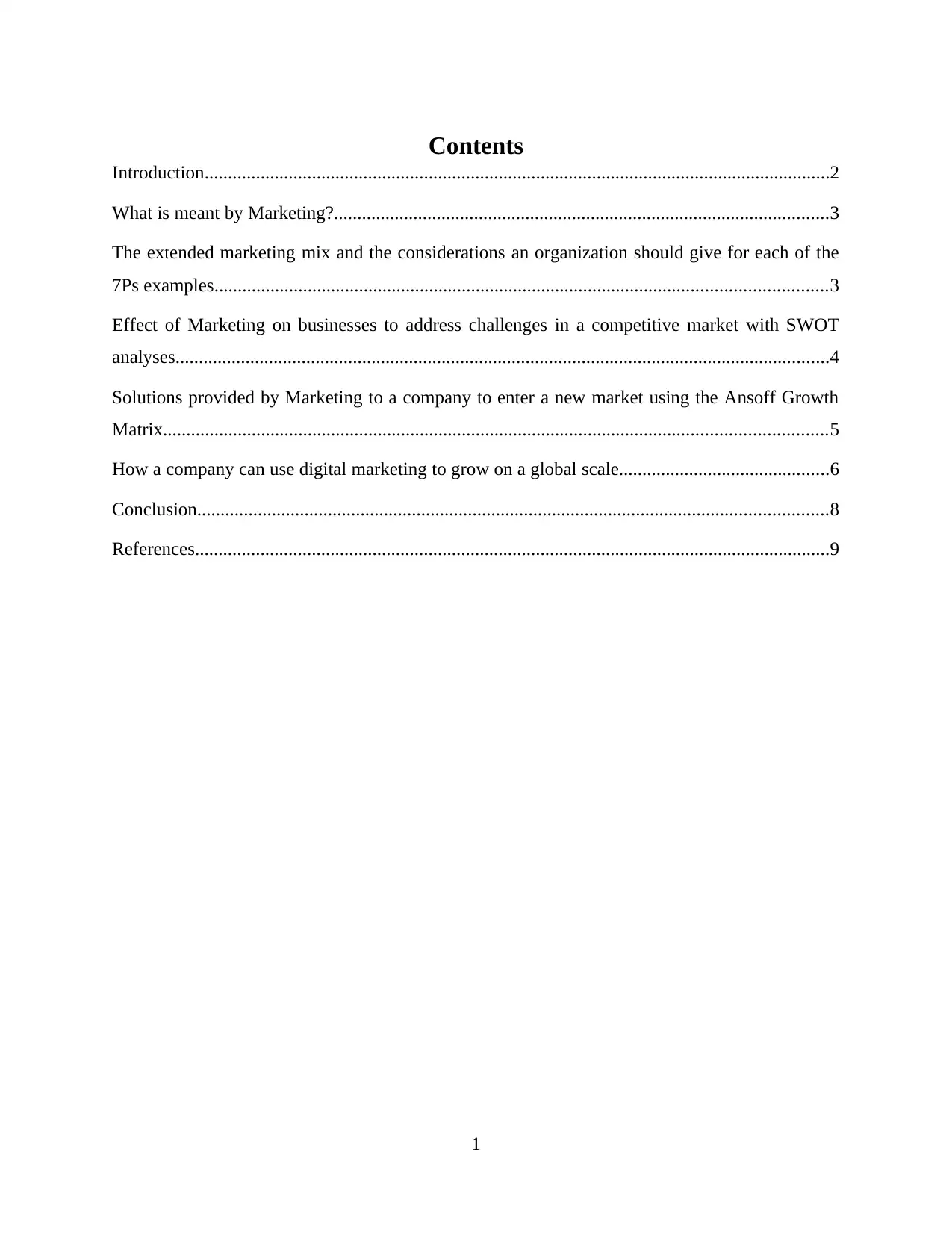
Contents
Introduction......................................................................................................................................2
What is meant by Marketing?..........................................................................................................3
The extended marketing mix and the considerations an organization should give for each of the
7Ps examples...................................................................................................................................3
Effect of Marketing on businesses to address challenges in a competitive market with SWOT
analyses............................................................................................................................................4
Solutions provided by Marketing to a company to enter a new market using the Ansoff Growth
Matrix..............................................................................................................................................5
How a company can use digital marketing to grow on a global scale.............................................6
Conclusion.......................................................................................................................................8
References........................................................................................................................................9
1
Introduction......................................................................................................................................2
What is meant by Marketing?..........................................................................................................3
The extended marketing mix and the considerations an organization should give for each of the
7Ps examples...................................................................................................................................3
Effect of Marketing on businesses to address challenges in a competitive market with SWOT
analyses............................................................................................................................................4
Solutions provided by Marketing to a company to enter a new market using the Ansoff Growth
Matrix..............................................................................................................................................5
How a company can use digital marketing to grow on a global scale.............................................6
Conclusion.......................................................................................................................................8
References........................................................................................................................................9
1
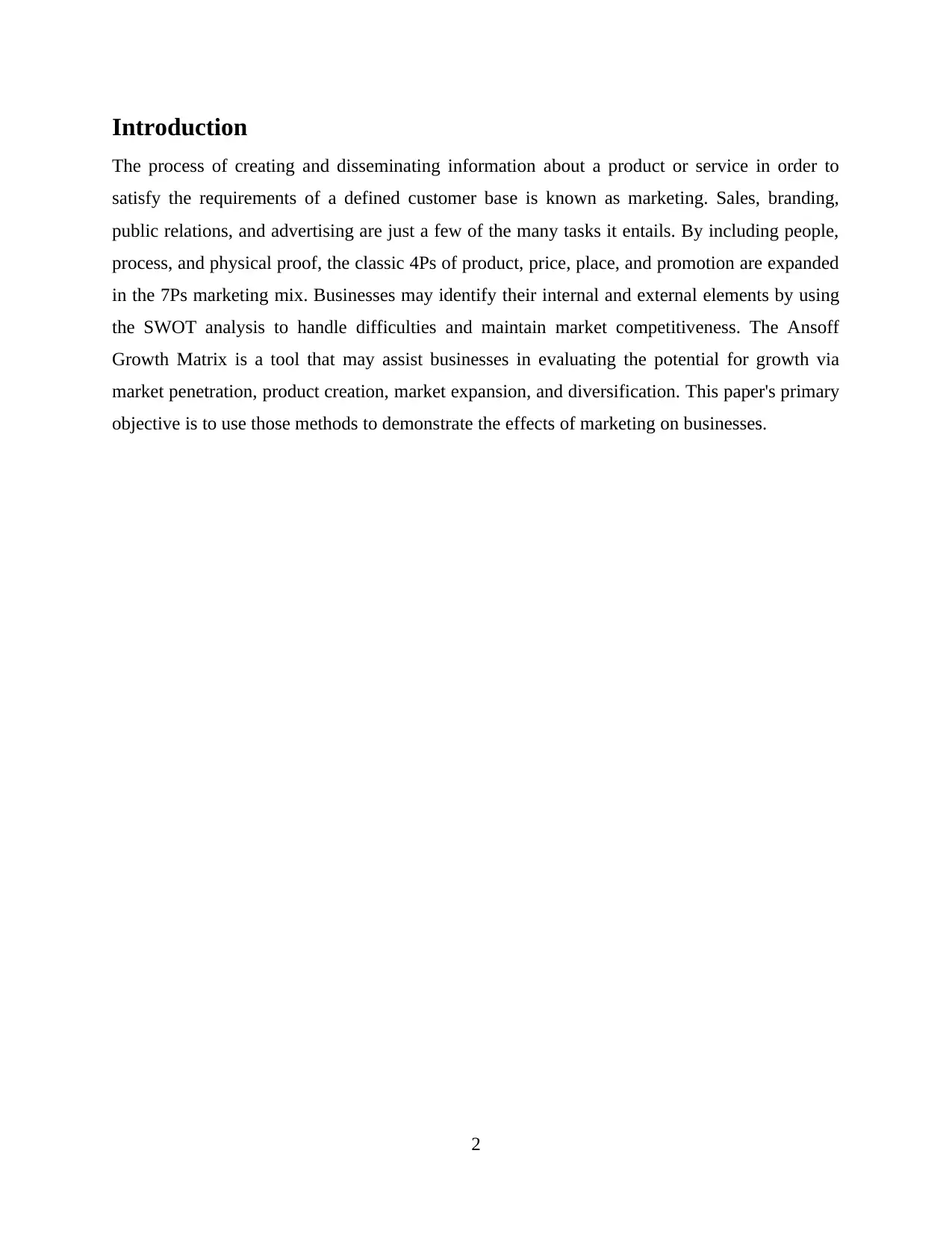
Introduction
The process of creating and disseminating information about a product or service in order to
satisfy the requirements of a defined customer base is known as marketing. Sales, branding,
public relations, and advertising are just a few of the many tasks it entails. By including people,
process, and physical proof, the classic 4Ps of product, price, place, and promotion are expanded
in the 7Ps marketing mix. Businesses may identify their internal and external elements by using
the SWOT analysis to handle difficulties and maintain market competitiveness. The Ansoff
Growth Matrix is a tool that may assist businesses in evaluating the potential for growth via
market penetration, product creation, market expansion, and diversification. This paper's primary
objective is to use those methods to demonstrate the effects of marketing on businesses.
2
The process of creating and disseminating information about a product or service in order to
satisfy the requirements of a defined customer base is known as marketing. Sales, branding,
public relations, and advertising are just a few of the many tasks it entails. By including people,
process, and physical proof, the classic 4Ps of product, price, place, and promotion are expanded
in the 7Ps marketing mix. Businesses may identify their internal and external elements by using
the SWOT analysis to handle difficulties and maintain market competitiveness. The Ansoff
Growth Matrix is a tool that may assist businesses in evaluating the potential for growth via
market penetration, product creation, market expansion, and diversification. This paper's primary
objective is to use those methods to demonstrate the effects of marketing on businesses.
2
⊘ This is a preview!⊘
Do you want full access?
Subscribe today to unlock all pages.

Trusted by 1+ million students worldwide
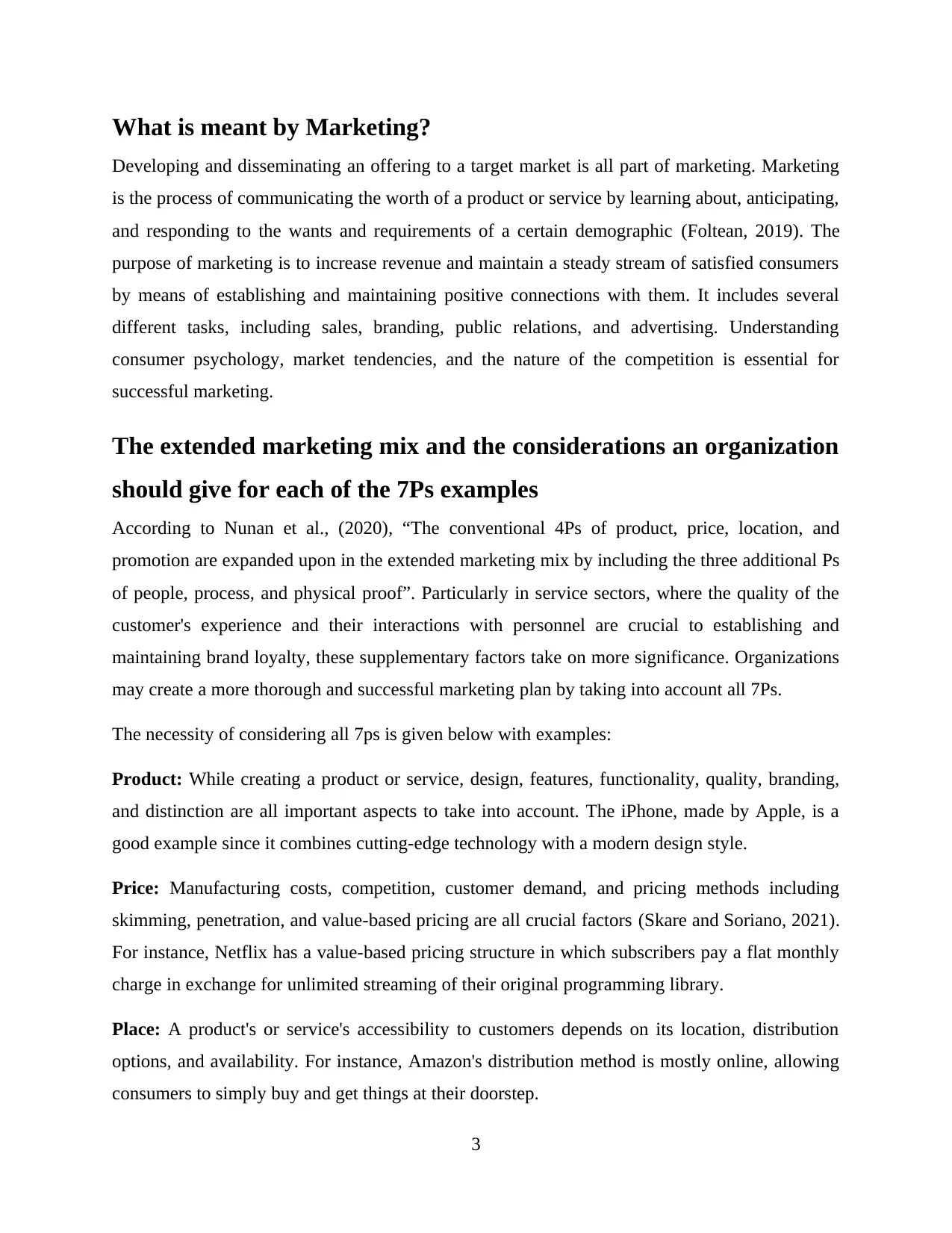
What is meant by Marketing?
Developing and disseminating an offering to a target market is all part of marketing. Marketing
is the process of communicating the worth of a product or service by learning about, anticipating,
and responding to the wants and requirements of a certain demographic (Foltean, 2019). The
purpose of marketing is to increase revenue and maintain a steady stream of satisfied consumers
by means of establishing and maintaining positive connections with them. It includes several
different tasks, including sales, branding, public relations, and advertising. Understanding
consumer psychology, market tendencies, and the nature of the competition is essential for
successful marketing.
The extended marketing mix and the considerations an organization
should give for each of the 7Ps examples
According to Nunan et al., (2020), “The conventional 4Ps of product, price, location, and
promotion are expanded upon in the extended marketing mix by including the three additional Ps
of people, process, and physical proof”. Particularly in service sectors, where the quality of the
customer's experience and their interactions with personnel are crucial to establishing and
maintaining brand loyalty, these supplementary factors take on more significance. Organizations
may create a more thorough and successful marketing plan by taking into account all 7Ps.
The necessity of considering all 7ps is given below with examples:
Product: While creating a product or service, design, features, functionality, quality, branding,
and distinction are all important aspects to take into account. The iPhone, made by Apple, is a
good example since it combines cutting-edge technology with a modern design style.
Price: Manufacturing costs, competition, customer demand, and pricing methods including
skimming, penetration, and value-based pricing are all crucial factors (Skare and Soriano, 2021).
For instance, Netflix has a value-based pricing structure in which subscribers pay a flat monthly
charge in exchange for unlimited streaming of their original programming library.
Place: A product's or service's accessibility to customers depends on its location, distribution
options, and availability. For instance, Amazon's distribution method is mostly online, allowing
consumers to simply buy and get things at their doorstep.
3
Developing and disseminating an offering to a target market is all part of marketing. Marketing
is the process of communicating the worth of a product or service by learning about, anticipating,
and responding to the wants and requirements of a certain demographic (Foltean, 2019). The
purpose of marketing is to increase revenue and maintain a steady stream of satisfied consumers
by means of establishing and maintaining positive connections with them. It includes several
different tasks, including sales, branding, public relations, and advertising. Understanding
consumer psychology, market tendencies, and the nature of the competition is essential for
successful marketing.
The extended marketing mix and the considerations an organization
should give for each of the 7Ps examples
According to Nunan et al., (2020), “The conventional 4Ps of product, price, location, and
promotion are expanded upon in the extended marketing mix by including the three additional Ps
of people, process, and physical proof”. Particularly in service sectors, where the quality of the
customer's experience and their interactions with personnel are crucial to establishing and
maintaining brand loyalty, these supplementary factors take on more significance. Organizations
may create a more thorough and successful marketing plan by taking into account all 7Ps.
The necessity of considering all 7ps is given below with examples:
Product: While creating a product or service, design, features, functionality, quality, branding,
and distinction are all important aspects to take into account. The iPhone, made by Apple, is a
good example since it combines cutting-edge technology with a modern design style.
Price: Manufacturing costs, competition, customer demand, and pricing methods including
skimming, penetration, and value-based pricing are all crucial factors (Skare and Soriano, 2021).
For instance, Netflix has a value-based pricing structure in which subscribers pay a flat monthly
charge in exchange for unlimited streaming of their original programming library.
Place: A product's or service's accessibility to customers depends on its location, distribution
options, and availability. For instance, Amazon's distribution method is mostly online, allowing
consumers to simply buy and get things at their doorstep.
3
Paraphrase This Document
Need a fresh take? Get an instant paraphrase of this document with our AI Paraphraser
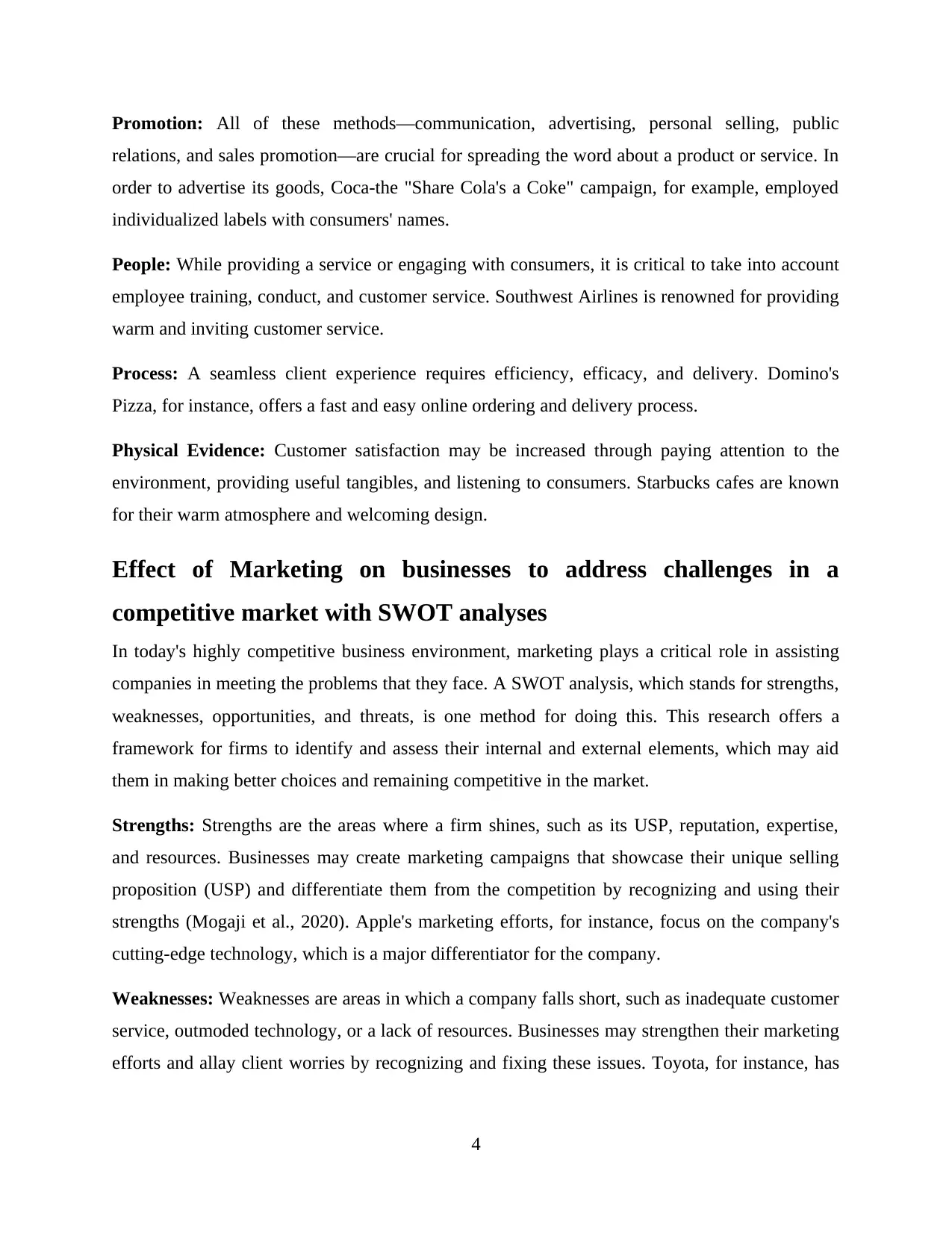
Promotion: All of these methods—communication, advertising, personal selling, public
relations, and sales promotion—are crucial for spreading the word about a product or service. In
order to advertise its goods, Coca-the "Share Cola's a Coke" campaign, for example, employed
individualized labels with consumers' names.
People: While providing a service or engaging with consumers, it is critical to take into account
employee training, conduct, and customer service. Southwest Airlines is renowned for providing
warm and inviting customer service.
Process: A seamless client experience requires efficiency, efficacy, and delivery. Domino's
Pizza, for instance, offers a fast and easy online ordering and delivery process.
Physical Evidence: Customer satisfaction may be increased through paying attention to the
environment, providing useful tangibles, and listening to consumers. Starbucks cafes are known
for their warm atmosphere and welcoming design.
Effect of Marketing on businesses to address challenges in a
competitive market with SWOT analyses
In today's highly competitive business environment, marketing plays a critical role in assisting
companies in meeting the problems that they face. A SWOT analysis, which stands for strengths,
weaknesses, opportunities, and threats, is one method for doing this. This research offers a
framework for firms to identify and assess their internal and external elements, which may aid
them in making better choices and remaining competitive in the market.
Strengths: Strengths are the areas where a firm shines, such as its USP, reputation, expertise,
and resources. Businesses may create marketing campaigns that showcase their unique selling
proposition (USP) and differentiate them from the competition by recognizing and using their
strengths (Mogaji et al., 2020). Apple's marketing efforts, for instance, focus on the company's
cutting-edge technology, which is a major differentiator for the company.
Weaknesses: Weaknesses are areas in which a company falls short, such as inadequate customer
service, outmoded technology, or a lack of resources. Businesses may strengthen their marketing
efforts and allay client worries by recognizing and fixing these issues. Toyota, for instance, has
4
relations, and sales promotion—are crucial for spreading the word about a product or service. In
order to advertise its goods, Coca-the "Share Cola's a Coke" campaign, for example, employed
individualized labels with consumers' names.
People: While providing a service or engaging with consumers, it is critical to take into account
employee training, conduct, and customer service. Southwest Airlines is renowned for providing
warm and inviting customer service.
Process: A seamless client experience requires efficiency, efficacy, and delivery. Domino's
Pizza, for instance, offers a fast and easy online ordering and delivery process.
Physical Evidence: Customer satisfaction may be increased through paying attention to the
environment, providing useful tangibles, and listening to consumers. Starbucks cafes are known
for their warm atmosphere and welcoming design.
Effect of Marketing on businesses to address challenges in a
competitive market with SWOT analyses
In today's highly competitive business environment, marketing plays a critical role in assisting
companies in meeting the problems that they face. A SWOT analysis, which stands for strengths,
weaknesses, opportunities, and threats, is one method for doing this. This research offers a
framework for firms to identify and assess their internal and external elements, which may aid
them in making better choices and remaining competitive in the market.
Strengths: Strengths are the areas where a firm shines, such as its USP, reputation, expertise,
and resources. Businesses may create marketing campaigns that showcase their unique selling
proposition (USP) and differentiate them from the competition by recognizing and using their
strengths (Mogaji et al., 2020). Apple's marketing efforts, for instance, focus on the company's
cutting-edge technology, which is a major differentiator for the company.
Weaknesses: Weaknesses are areas in which a company falls short, such as inadequate customer
service, outmoded technology, or a lack of resources. Businesses may strengthen their marketing
efforts and allay client worries by recognizing and fixing these issues. Toyota, for instance, has
4
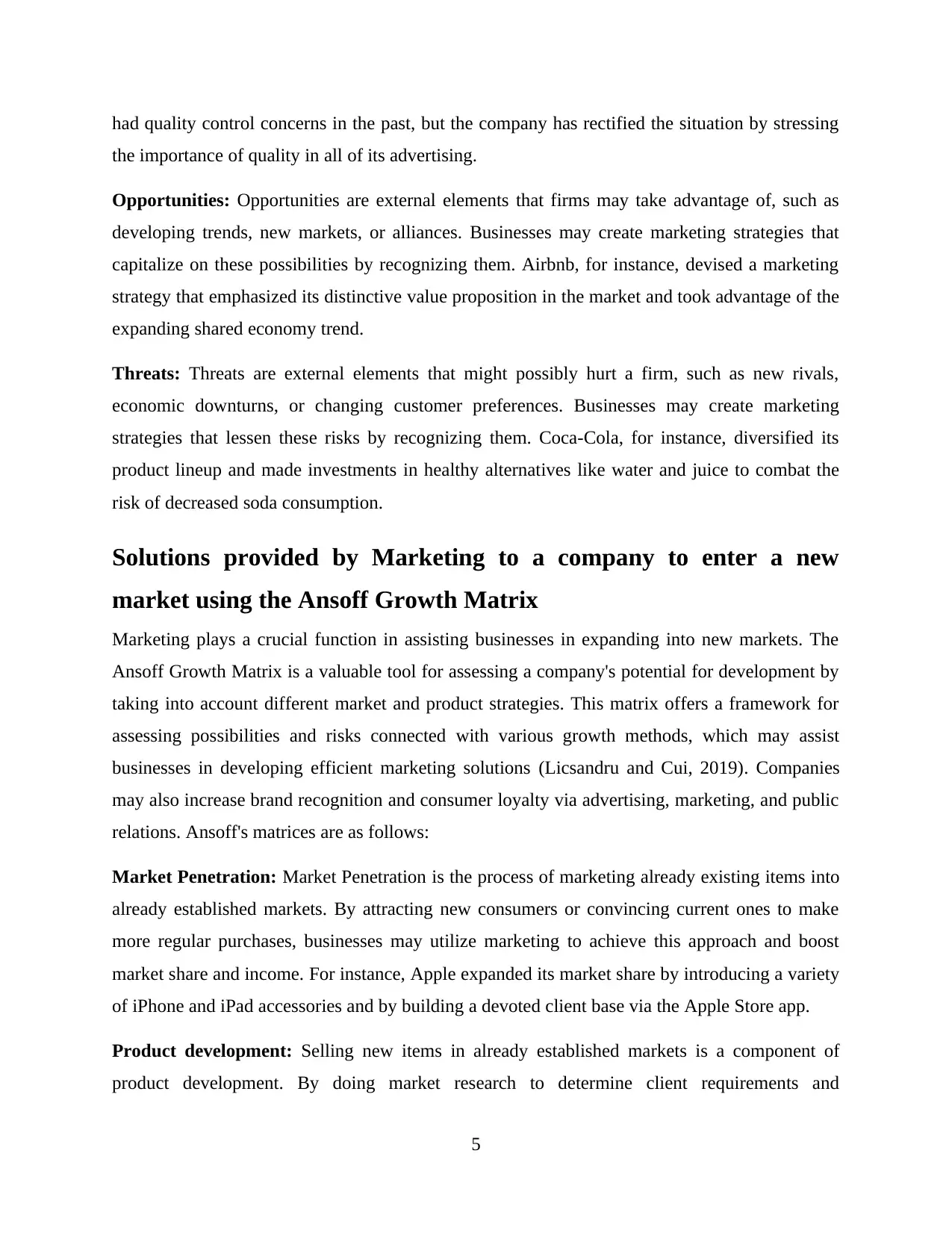
had quality control concerns in the past, but the company has rectified the situation by stressing
the importance of quality in all of its advertising.
Opportunities: Opportunities are external elements that firms may take advantage of, such as
developing trends, new markets, or alliances. Businesses may create marketing strategies that
capitalize on these possibilities by recognizing them. Airbnb, for instance, devised a marketing
strategy that emphasized its distinctive value proposition in the market and took advantage of the
expanding shared economy trend.
Threats: Threats are external elements that might possibly hurt a firm, such as new rivals,
economic downturns, or changing customer preferences. Businesses may create marketing
strategies that lessen these risks by recognizing them. Coca-Cola, for instance, diversified its
product lineup and made investments in healthy alternatives like water and juice to combat the
risk of decreased soda consumption.
Solutions provided by Marketing to a company to enter a new
market using the Ansoff Growth Matrix
Marketing plays a crucial function in assisting businesses in expanding into new markets. The
Ansoff Growth Matrix is a valuable tool for assessing a company's potential for development by
taking into account different market and product strategies. This matrix offers a framework for
assessing possibilities and risks connected with various growth methods, which may assist
businesses in developing efficient marketing solutions (Licsandru and Cui, 2019). Companies
may also increase brand recognition and consumer loyalty via advertising, marketing, and public
relations. Ansoff's matrices are as follows:
Market Penetration: Market Penetration is the process of marketing already existing items into
already established markets. By attracting new consumers or convincing current ones to make
more regular purchases, businesses may utilize marketing to achieve this approach and boost
market share and income. For instance, Apple expanded its market share by introducing a variety
of iPhone and iPad accessories and by building a devoted client base via the Apple Store app.
Product development: Selling new items in already established markets is a component of
product development. By doing market research to determine client requirements and
5
the importance of quality in all of its advertising.
Opportunities: Opportunities are external elements that firms may take advantage of, such as
developing trends, new markets, or alliances. Businesses may create marketing strategies that
capitalize on these possibilities by recognizing them. Airbnb, for instance, devised a marketing
strategy that emphasized its distinctive value proposition in the market and took advantage of the
expanding shared economy trend.
Threats: Threats are external elements that might possibly hurt a firm, such as new rivals,
economic downturns, or changing customer preferences. Businesses may create marketing
strategies that lessen these risks by recognizing them. Coca-Cola, for instance, diversified its
product lineup and made investments in healthy alternatives like water and juice to combat the
risk of decreased soda consumption.
Solutions provided by Marketing to a company to enter a new
market using the Ansoff Growth Matrix
Marketing plays a crucial function in assisting businesses in expanding into new markets. The
Ansoff Growth Matrix is a valuable tool for assessing a company's potential for development by
taking into account different market and product strategies. This matrix offers a framework for
assessing possibilities and risks connected with various growth methods, which may assist
businesses in developing efficient marketing solutions (Licsandru and Cui, 2019). Companies
may also increase brand recognition and consumer loyalty via advertising, marketing, and public
relations. Ansoff's matrices are as follows:
Market Penetration: Market Penetration is the process of marketing already existing items into
already established markets. By attracting new consumers or convincing current ones to make
more regular purchases, businesses may utilize marketing to achieve this approach and boost
market share and income. For instance, Apple expanded its market share by introducing a variety
of iPhone and iPad accessories and by building a devoted client base via the Apple Store app.
Product development: Selling new items in already established markets is a component of
product development. By doing market research to determine client requirements and
5
⊘ This is a preview!⊘
Do you want full access?
Subscribe today to unlock all pages.

Trusted by 1+ million students worldwide
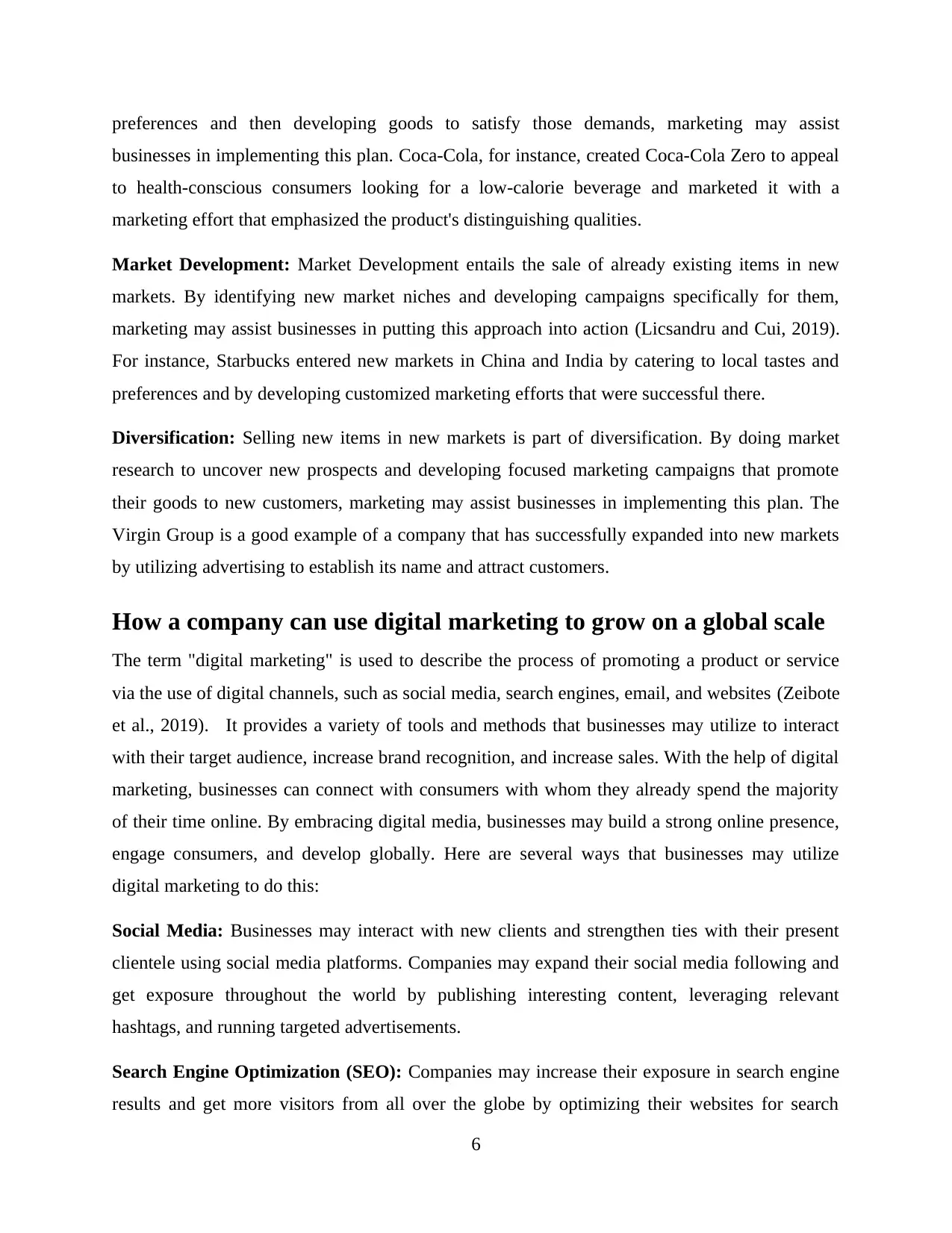
preferences and then developing goods to satisfy those demands, marketing may assist
businesses in implementing this plan. Coca-Cola, for instance, created Coca-Cola Zero to appeal
to health-conscious consumers looking for a low-calorie beverage and marketed it with a
marketing effort that emphasized the product's distinguishing qualities.
Market Development: Market Development entails the sale of already existing items in new
markets. By identifying new market niches and developing campaigns specifically for them,
marketing may assist businesses in putting this approach into action (Licsandru and Cui, 2019).
For instance, Starbucks entered new markets in China and India by catering to local tastes and
preferences and by developing customized marketing efforts that were successful there.
Diversification: Selling new items in new markets is part of diversification. By doing market
research to uncover new prospects and developing focused marketing campaigns that promote
their goods to new customers, marketing may assist businesses in implementing this plan. The
Virgin Group is a good example of a company that has successfully expanded into new markets
by utilizing advertising to establish its name and attract customers.
How a company can use digital marketing to grow on a global scale
The term "digital marketing" is used to describe the process of promoting a product or service
via the use of digital channels, such as social media, search engines, email, and websites (Zeibote
et al., 2019). It provides a variety of tools and methods that businesses may utilize to interact
with their target audience, increase brand recognition, and increase sales. With the help of digital
marketing, businesses can connect with consumers with whom they already spend the majority
of their time online. By embracing digital media, businesses may build a strong online presence,
engage consumers, and develop globally. Here are several ways that businesses may utilize
digital marketing to do this:
Social Media: Businesses may interact with new clients and strengthen ties with their present
clientele using social media platforms. Companies may expand their social media following and
get exposure throughout the world by publishing interesting content, leveraging relevant
hashtags, and running targeted advertisements.
Search Engine Optimization (SEO): Companies may increase their exposure in search engine
results and get more visitors from all over the globe by optimizing their websites for search
6
businesses in implementing this plan. Coca-Cola, for instance, created Coca-Cola Zero to appeal
to health-conscious consumers looking for a low-calorie beverage and marketed it with a
marketing effort that emphasized the product's distinguishing qualities.
Market Development: Market Development entails the sale of already existing items in new
markets. By identifying new market niches and developing campaigns specifically for them,
marketing may assist businesses in putting this approach into action (Licsandru and Cui, 2019).
For instance, Starbucks entered new markets in China and India by catering to local tastes and
preferences and by developing customized marketing efforts that were successful there.
Diversification: Selling new items in new markets is part of diversification. By doing market
research to uncover new prospects and developing focused marketing campaigns that promote
their goods to new customers, marketing may assist businesses in implementing this plan. The
Virgin Group is a good example of a company that has successfully expanded into new markets
by utilizing advertising to establish its name and attract customers.
How a company can use digital marketing to grow on a global scale
The term "digital marketing" is used to describe the process of promoting a product or service
via the use of digital channels, such as social media, search engines, email, and websites (Zeibote
et al., 2019). It provides a variety of tools and methods that businesses may utilize to interact
with their target audience, increase brand recognition, and increase sales. With the help of digital
marketing, businesses can connect with consumers with whom they already spend the majority
of their time online. By embracing digital media, businesses may build a strong online presence,
engage consumers, and develop globally. Here are several ways that businesses may utilize
digital marketing to do this:
Social Media: Businesses may interact with new clients and strengthen ties with their present
clientele using social media platforms. Companies may expand their social media following and
get exposure throughout the world by publishing interesting content, leveraging relevant
hashtags, and running targeted advertisements.
Search Engine Optimization (SEO): Companies may increase their exposure in search engine
results and get more visitors from all over the globe by optimizing their websites for search
6
Paraphrase This Document
Need a fresh take? Get an instant paraphrase of this document with our AI Paraphraser
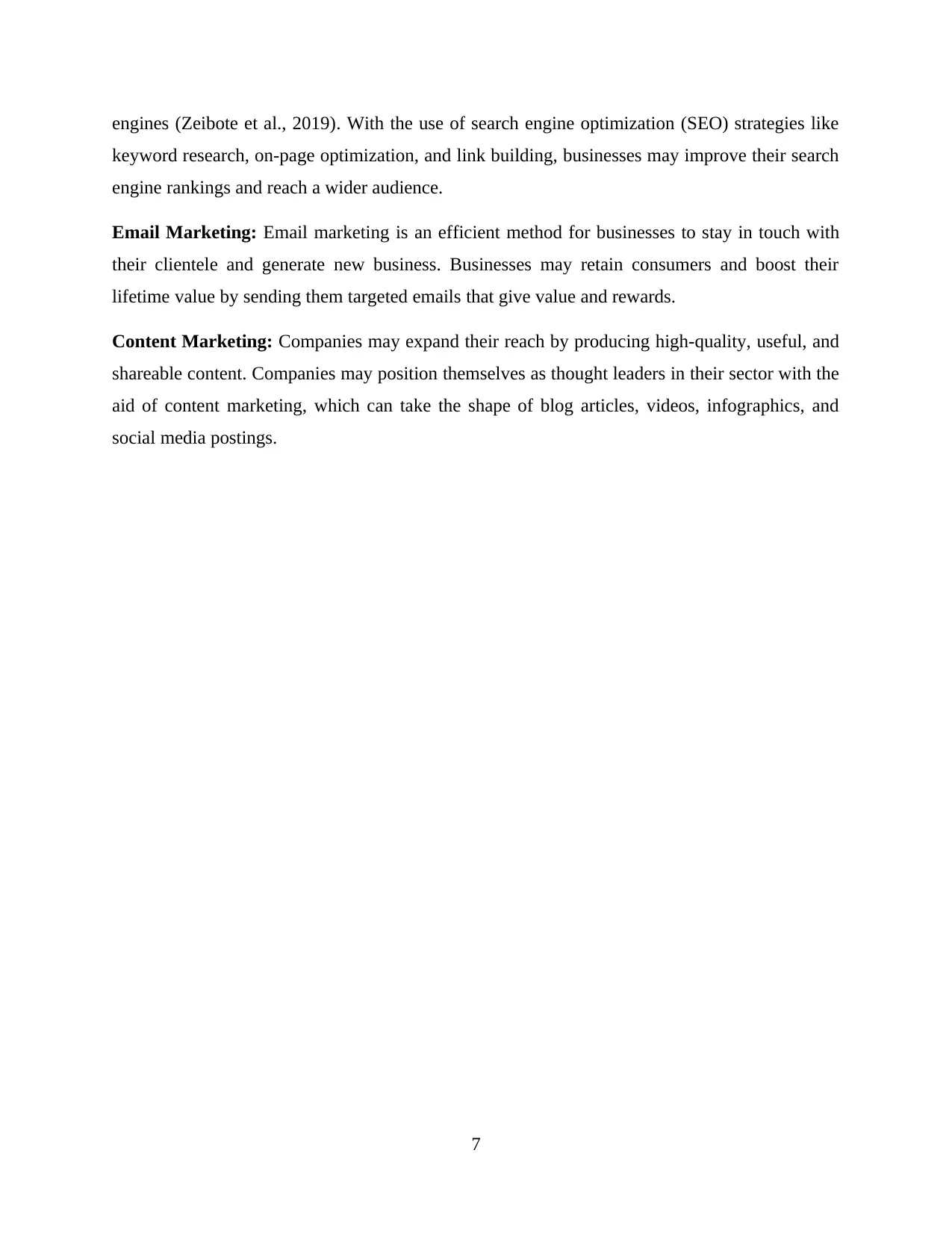
engines (Zeibote et al., 2019). With the use of search engine optimization (SEO) strategies like
keyword research, on-page optimization, and link building, businesses may improve their search
engine rankings and reach a wider audience.
Email Marketing: Email marketing is an efficient method for businesses to stay in touch with
their clientele and generate new business. Businesses may retain consumers and boost their
lifetime value by sending them targeted emails that give value and rewards.
Content Marketing: Companies may expand their reach by producing high-quality, useful, and
shareable content. Companies may position themselves as thought leaders in their sector with the
aid of content marketing, which can take the shape of blog articles, videos, infographics, and
social media postings.
7
keyword research, on-page optimization, and link building, businesses may improve their search
engine rankings and reach a wider audience.
Email Marketing: Email marketing is an efficient method for businesses to stay in touch with
their clientele and generate new business. Businesses may retain consumers and boost their
lifetime value by sending them targeted emails that give value and rewards.
Content Marketing: Companies may expand their reach by producing high-quality, useful, and
shareable content. Companies may position themselves as thought leaders in their sector with the
aid of content marketing, which can take the shape of blog articles, videos, infographics, and
social media postings.
7
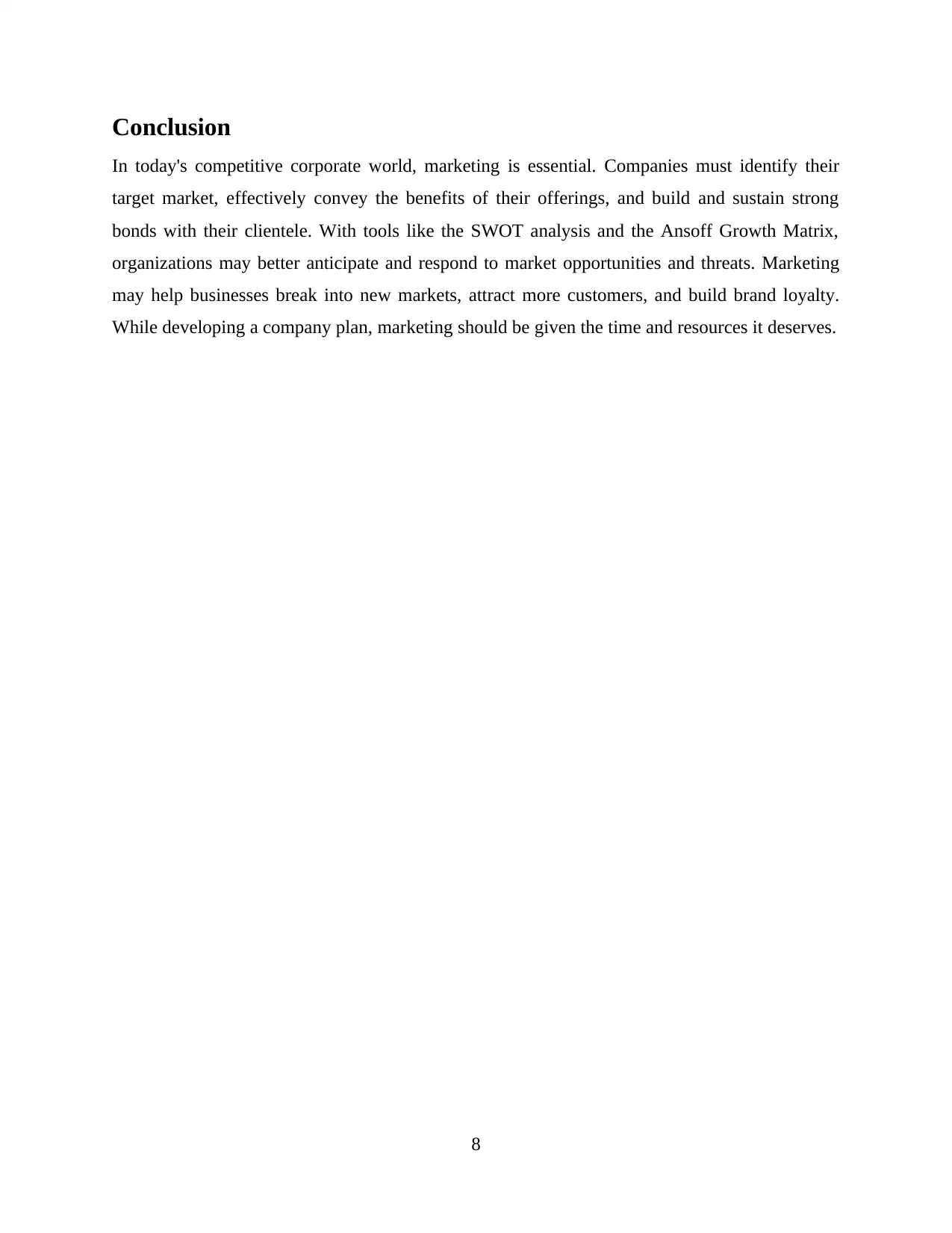
Conclusion
In today's competitive corporate world, marketing is essential. Companies must identify their
target market, effectively convey the benefits of their offerings, and build and sustain strong
bonds with their clientele. With tools like the SWOT analysis and the Ansoff Growth Matrix,
organizations may better anticipate and respond to market opportunities and threats. Marketing
may help businesses break into new markets, attract more customers, and build brand loyalty.
While developing a company plan, marketing should be given the time and resources it deserves.
8
In today's competitive corporate world, marketing is essential. Companies must identify their
target market, effectively convey the benefits of their offerings, and build and sustain strong
bonds with their clientele. With tools like the SWOT analysis and the Ansoff Growth Matrix,
organizations may better anticipate and respond to market opportunities and threats. Marketing
may help businesses break into new markets, attract more customers, and build brand loyalty.
While developing a company plan, marketing should be given the time and resources it deserves.
8
⊘ This is a preview!⊘
Do you want full access?
Subscribe today to unlock all pages.

Trusted by 1+ million students worldwide
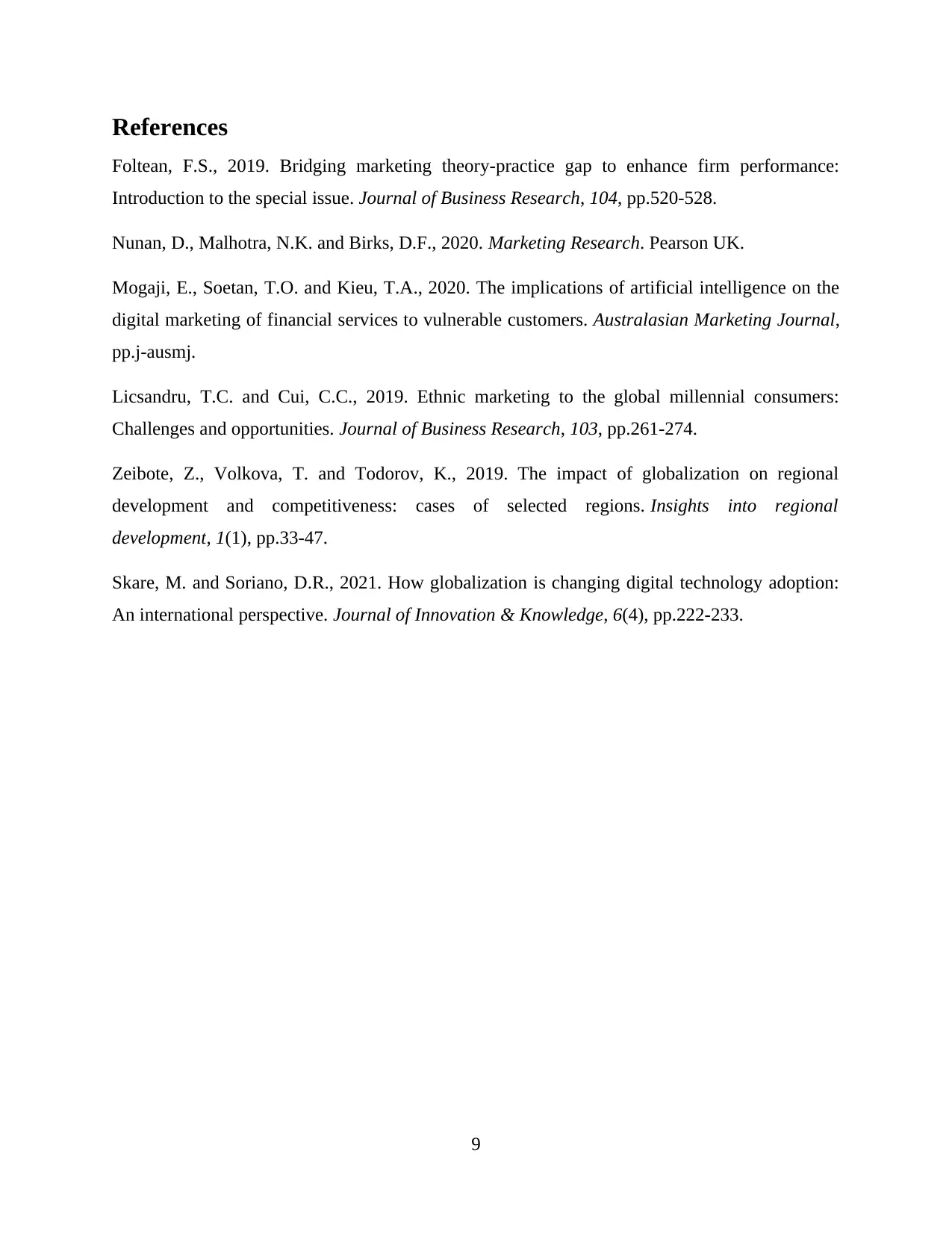
References
Foltean, F.S., 2019. Bridging marketing theory-practice gap to enhance firm performance:
Introduction to the special issue. Journal of Business Research, 104, pp.520-528.
Nunan, D., Malhotra, N.K. and Birks, D.F., 2020. Marketing Research. Pearson UK.
Mogaji, E., Soetan, T.O. and Kieu, T.A., 2020. The implications of artificial intelligence on the
digital marketing of financial services to vulnerable customers. Australasian Marketing Journal,
pp.j-ausmj.
Licsandru, T.C. and Cui, C.C., 2019. Ethnic marketing to the global millennial consumers:
Challenges and opportunities. Journal of Business Research, 103, pp.261-274.
Zeibote, Z., Volkova, T. and Todorov, K., 2019. The impact of globalization on regional
development and competitiveness: cases of selected regions. Insights into regional
development, 1(1), pp.33-47.
Skare, M. and Soriano, D.R., 2021. How globalization is changing digital technology adoption:
An international perspective. Journal of Innovation & Knowledge, 6(4), pp.222-233.
9
Foltean, F.S., 2019. Bridging marketing theory-practice gap to enhance firm performance:
Introduction to the special issue. Journal of Business Research, 104, pp.520-528.
Nunan, D., Malhotra, N.K. and Birks, D.F., 2020. Marketing Research. Pearson UK.
Mogaji, E., Soetan, T.O. and Kieu, T.A., 2020. The implications of artificial intelligence on the
digital marketing of financial services to vulnerable customers. Australasian Marketing Journal,
pp.j-ausmj.
Licsandru, T.C. and Cui, C.C., 2019. Ethnic marketing to the global millennial consumers:
Challenges and opportunities. Journal of Business Research, 103, pp.261-274.
Zeibote, Z., Volkova, T. and Todorov, K., 2019. The impact of globalization on regional
development and competitiveness: cases of selected regions. Insights into regional
development, 1(1), pp.33-47.
Skare, M. and Soriano, D.R., 2021. How globalization is changing digital technology adoption:
An international perspective. Journal of Innovation & Knowledge, 6(4), pp.222-233.
9
1 out of 10
Related Documents
Your All-in-One AI-Powered Toolkit for Academic Success.
+13062052269
info@desklib.com
Available 24*7 on WhatsApp / Email
![[object Object]](/_next/static/media/star-bottom.7253800d.svg)
Unlock your academic potential
Copyright © 2020–2025 A2Z Services. All Rights Reserved. Developed and managed by ZUCOL.

